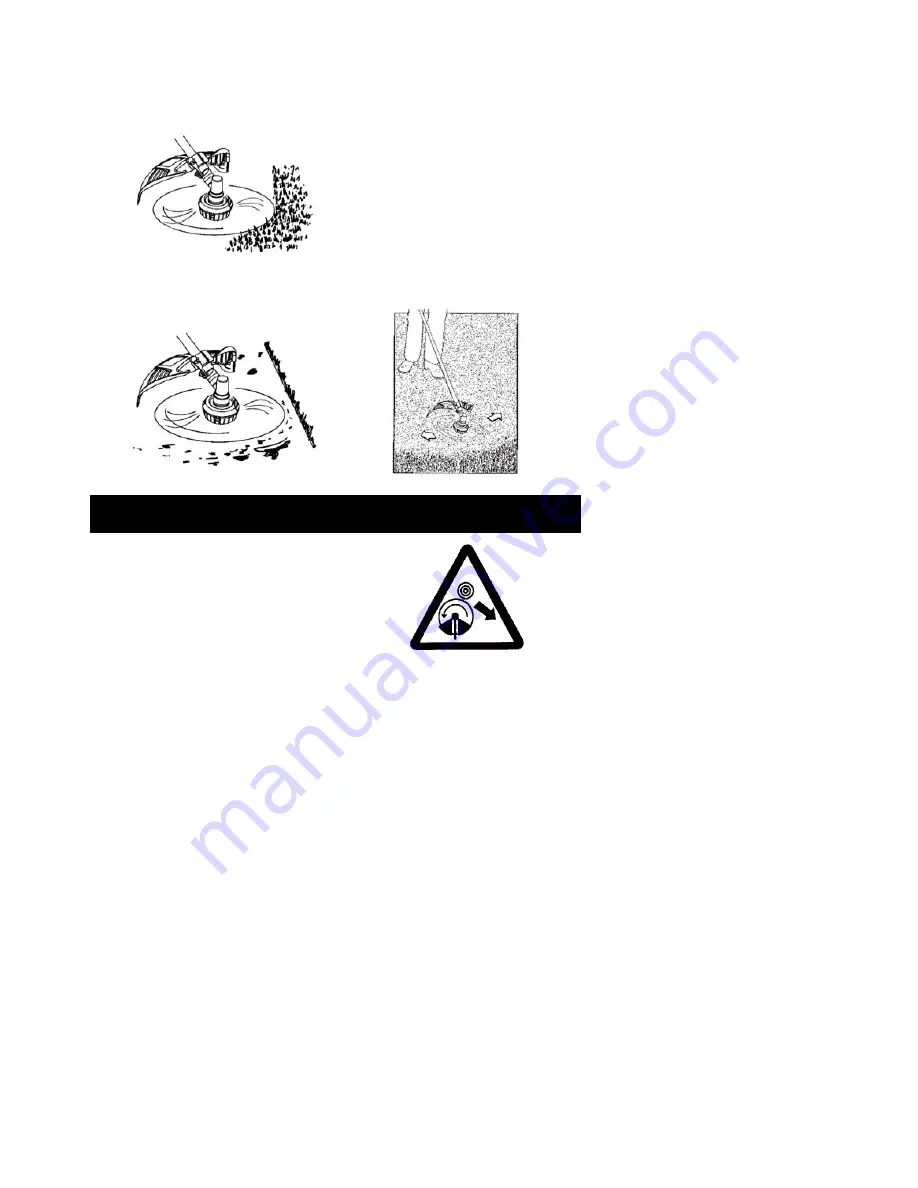
-- 10 --
MOWING - Your trimmer is ideal for mowing
in places conventional lawn mowers cannot
reach. In the mowing position, keep the line
parallel to the ground. Avoid pressing the
head into the ground as this can scalp the
ground and damage the tool.
Mowing
SWEEPING - The fanning action of the
rotating line can be used to blow away loose
debris from an area. Keep the line parallel to
and above the area surface and swing the
tool from side to side.
Sweeping
TRIMMING PROCEDURES
When properly equipped with a cutting
attachment guard and cutting head, your unit
will trim unsightly weeds and tall grass in
those hard-to-reach areas - along fences,
walls, foundations and around trees. It can
also be used for scalping to remove
vegetation down to the ground for easier
preparation of a garden or to clean out a
particular area.
NOTE:
Even with care, trimming around
foundations, brick or stone walls, curves,
etc., will result in above normal string wear.
TRIMMING / MOWING
Swing trimmer with a sickle-like motion from
side to side. Do not tilt the cutting head during
the procedure. Test area to be trimmed for
proper cutting height. Keep cutting head at
same level for even depth of cut (Fig. 12A).
Fig. 12A
OPERATING INSTRUCTIONS FOR USE WITH BLADE
•
Blade Thrust
is a reaction that only occurs
when using a bladed unit. This reaction
can cause serious injury such as
amputation. Carefully study this section. It
is important that you understand what
causes blade thrust, how you can reduce
the chance of its occurring, and how you
can remain in control of unit if blade thrust
occurs.
•
WHAT CAUSES BLADE THRUST -
Blade Thrust
can occur when the spinning
blade contacts an object that it does not
cut. This contact causes the blade to stop
for an instant and then suddenly move or
“thrust” away from the object that was hit.
The “thrusting” reaction can be violent
enough to cause the operator to be
propelled in any direction and lose control
of the unit. The uncontrolled unit can cause
serious injury if the blade contacts the
operator or others.
•
WHEN BLADE THRUST OCCURS -
Blade Thrust
can occur without warning if
the blade snags, stalls, or binds. This is
more likely to occur in areas where it is
difficult to see the material being cut. By
using the unit properly, the occurrence of
blade thrust will be reduced and the
operator will be less likely to lose control.
•
Cut only grass, weeds, and woody brush
up to 1 cm in diameter with the weed
blade. Do not let the blade contact
material it cannot cut such as stumps,
rocks, fences, metal, etc., or clusters of
hard, woody brush having a diameter
greater than 1 cm.
•
Keep the blade sharp. A dull blade is more
likely to snag and thrust.
•
Cut only at full throttle. The blade will have
maximum cutting power and is less likely
to bind or stall.
•
“Feed” the blade deliberately and not too
rapidly. The blade can thrust away if it is
fed too rapidly.
•
Cut only from your left to your right.
Cutting on right side of the shield will
throw debris away from the operator.
Summary of Contents for T265 CPS
Page 18: ...18 15 50 15m 50ft 3 10...
Page 19: ...19 2 P 15 50 15 50 15 50 15 50 ZU VERMEIDEN...
Page 20: ...20 2A 2B 2C D A E E D B C C B 1 2 3 1 3 1 A 2A 2 B C D E 2B 3 A 2C 1 A B 250 2 A B...
Page 21: ...21 1 2 3 1 2 3 4 5...
Page 24: ...24 A 9E 9F A B 9G 9H 1 10A 2 10B 3 4 6 5 5 5 9A 10A 10B 9B 13cm 0 300mm 100 400mm 9C 9D A...
Page 25: ...25 8 8 8 2 4...
Page 26: ...26 12A 1 1 12A...
Page 27: ...27 2 3 4 4 5 2 4 9 5 6 7 8 1 2 4 2 4...
Page 28: ...28 1 A B C 16 2 3 4 16 C B A 10 11...
Page 30: ...30 40 1...
Page 125: ...125 15 15m 50ft 3 15 15...
Page 126: ...126 2 P 15 15 1 250 A 2...
Page 127: ...127 2A 2 2 D A E E D B C C B 1 2 3 1 3 1 A 2A 2 2 3 2...
Page 128: ...128 1 2 3 1 2 3 4 5 6 7...
Page 132: ...132 8 12A 8 8...
Page 133: ...133 12 1 1...
Page 134: ...134 2 3 4 4 5 2 4 9 5 6 7 8 1 2 4 2 4...
Page 135: ...135 1 A 16 2 3 4 1 A 17A 17 16 C B A 10 11...
Page 137: ...137 RUN 40 1...











































